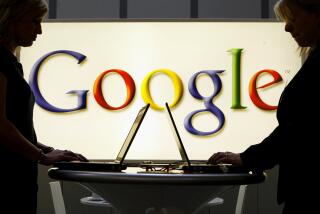Microsoft to Face More Competitors in Future
- Share via
Microsoft Corp. largely escaped punishment in Friday’s landmark court ruling. But it has yet to be seen whether it will be so lucky in the marketplace.
In accepting the antitrust settlement that Microsoft had reached with the Justice Department, U.S. District Judge Colleen Kollar-Kotelly gave the Redmond, Wash., software giant almost everything it was looking for. California and the eight other states that had been pressing for stricter sanctions against the company were rebuffed.
Yet in many ways, the judge’s ruling is moot.
The case centered on Windows, Microsoft’s flagship operating system, which is used to run more than 90% of the world’s personal computers. The future, though, is about the Internet -- a place where PCs are increasingly less important.
In fact, Microsoft Chairman Bill Gates and President Steve Ballmer long ago moved on to the new world of expanded communications and computing over the World Wide Web.
Before the decade is out, according to Forrester Research, more than 14 billion devices will be programmed and operated over the Internet -- many of them having nothing to do with PCs. Among these gizmos: souped-up telephones, hand-held computers and even pumps for intravenous delivery of medicines.
“The number of devices connecting to the Internet will be more than 25 times the number of computers today,” says Maria Martinez, president of Embrace Networks Inc., a start-up based in Sunnyvale, Calif., that has developed software to manage the flood of signals and devices on the expanded Internet.
The race is on to establish standardized platforms to allow these billions of devices to communicate and cooperate -- machines talking to machines.
Microsoft has been working for more than two years to develop its own platform for the business community, called .Net.
But it is not alone. Competitors, including giant IBM Corp., have other ideas, and they are pushing development of “open source” systems for the expanded Internet. Such systems use computer codes that anyone can access, so all programmers are on an equal footing.
Many firms are working with forms of the Java computer language, which originated with Sun Microsystems Inc. Java’s “virtual machines” are designed to run well on computers that use Microsoft Windows or any competing operating system.
In addition, the Linux operating system, which runs databases for corporations and big institutions, is an open source technology that is supported by IBM and other companies. It’s also backed by “the growing computer universes in China and India and other countries,” says technologist Paul Saffo, director of the Institute for the Future, a Palo Alto think tank.
The point is that as Microsoft moves on with evolving technology, many others are moving on too. The company is bound to face strong competition on all commercial battlefields in the future.
Right now, Microsoft is focusing its efforts on the $150-billion market of information services for small and medium-sized companies. In the last two years, Microsoft has spent $4 billion to acquire software firms catering to the small-business market, including Great Plains Software and Denmark’s Navision.
But IBM is targeting that same market. Some of the $10 billion it has set aside for new product development is being dedicated to adapting its big-company software products to meet the needs -- and price ranges -- of smaller companies.
On the consumer front, Microsoft is trying hard to increase the market share of its MSN Internet service, where it runs a distant second to America Online. Although Microsoft has invested heavily in promoting MSN for five years now, it has not seen much profit from its labors. Nor has it gained much on America Online, which has 30 million customers to MSN’s 9 million.
Microsoft doesn’t win them all, but it keeps on coming, spending heavily on research and development to better its products.
Microsoft’s operating system initially conquered Apple Computer Inc.’s Macintosh desktop computer format in the 1980s, as it persuaded IBM and other computer manufacturers to use Windows. It then improved on Windows, partly by copying Apple’s user-friendly system of icons and mouse clicks.
Microsoft then used the leverage it had with Windows to push its Web browser, Internet Explorer. By bundling its ubiquitous Windows with Internet Explorer, Microsoft managed to sink rival Netscape Navigator in the browser market -- a tactic later ruled illegal in the long-running antitrust case.
Meanwhile, although Microsoft remains the nation’s most valuable company, its growth has stalled. Though revenue has increased, on average, 12% a year, earnings have grown less than 2% annually since 1999. Microsoft stock, which trades on Nasdaq, now sells for less than half its all-time high reached three years ago.
With the judge’s decision Friday, it is certain that Microsoft won’t be broken up as Standard Oil once was. Yet the sheer enormity of changes coming in technology means that the company won’t dominate the Internet future as it did the personal computing past.
The juggernaut rolls on -- but there will be more bumps in the road than ever before.
*
James Flanigan can be reached at jim.flanigan@latimes.com.
More to Read
Inside the business of entertainment
The Wide Shot brings you news, analysis and insights on everything from streaming wars to production — and what it all means for the future.
You may occasionally receive promotional content from the Los Angeles Times.










